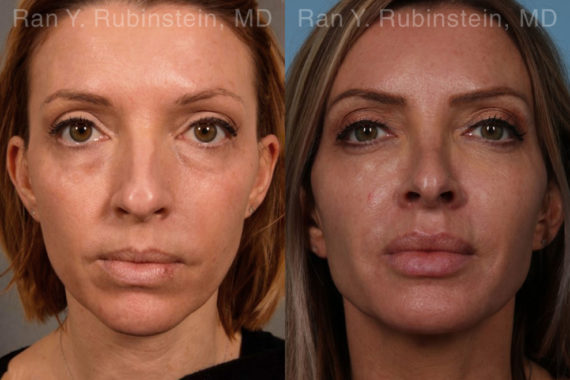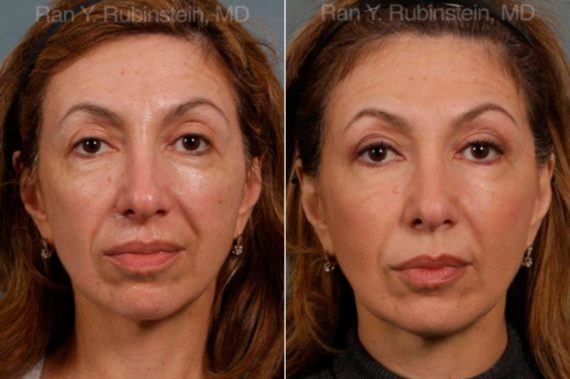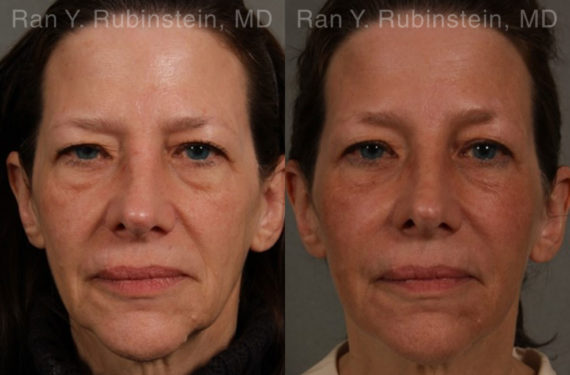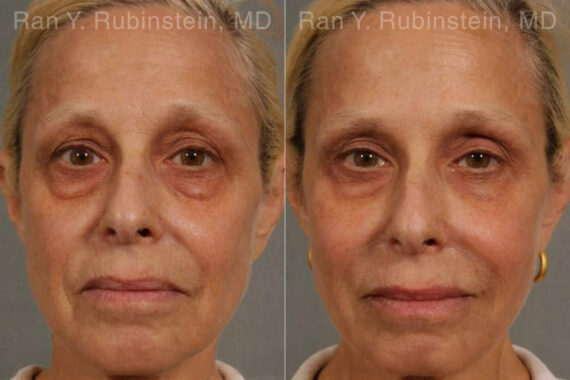Sculptra vs. Hyaluronic Acid Fillers: Choosing the Right Treatment After Weight Loss
Posted by Rubinstein Plastic Surgery Center

Losing weight—especially quickly or through medications like Ozempic—can be a life-changing health achievement. But many people are surprised by how this success story can show up on their face. As pounds disappear, so does facial volume, often leaving behind a more gaunt or aged appearance. This has become such a common concern that it now has a name: “Ozempic face.”
If you’re seeing new hollowness in your cheeks or sagging skin that makes you look older than you feel, you’re not alone. Fortunately, there are solutions. Injectable treatments like Sculptra and hyaluronic acid-based fillers can help restore youthful plumpness and improve skin texture. But how do you choose the right one?
In this guide, we’ll break down the differences between Sculptra vs fillers made of hyaluronic acid, explore what makes each treatment unique, and help you determine the best option for your needs.
5 Things You Should Know About Sculptra and Other Fillers After Weight Loss
- Rapid weight loss can cause a loss of facial volume, resulting in sagging skin and hollow features.
- Sculptra is an injectable collagen stimulator that works gradually to restore volume and improve skin texture.
- Traditional fillers like Juvederm use hyaluronic acid to provide immediate volume in targeted areas.
- Sculptra results develop over time and last longer than most hyaluronic acid-based fillers.
- Consulting with a board-certified facial plastic surgeon is the best way to determine which treatment fits your aesthetic goals.
What Happens to the Face After Rapid Weight Loss?
Weight loss is usually seen as a positive step toward better health, but the effects on your face can be more complicated. When the body loses fat quickly, it doesn’t discriminate between the waistline and the cheeks. Facial fat pads—especially in the midface and temples—shrink, which can lead to:
- Hollow cheeks
- Loose or sagging skin
- Deeper lines and wrinkles
- A more tired or aged appearance
These changes are particularly noticeable after significant or rapid weight loss, as with GLP-1 medications like Ozempic. For many patients, facial changes are not only cosmetic but emotional—your reflection no longer matches how strong or healthy you feel. Injectable treatments like Sculptra and dermal fillers can help bridge that gap.
What is Sculptra?
Sculptra is an injectable treatment made from poly-L-lactic acid (PLLA), a biocompatible substance that works as a collagen stimulator. While it’s often grouped with dermal fillers, Sculptra works differently than hyaluronic acid fillers by stimulating your body’s own collagen rather than simply adding volume with a gel-like substance. Over several months, collagen rebuilds the skin’s internal structure, restoring volume and improving texture.
Sculptra is ideal for patients who want natural-looking results that improve over time. It’s often used in a “Sculptra facelift” approach to subtly lift and volumize the face without surgery.
Sculptra treatment is especially effective for:
- Hollow cheeks
- Sunken temples
- Smile lines
- Jawline definition
- General facial volume loss
Sculptra Patient Results


* All patients are unique and individual results may vary.
What are Dermal Fillers?
The most common type of dermal fillers are made from hyaluronic acid (HA), a naturally occurring substance in the skin. These HA-based fillers—such as Juvederm or Restylane—are used to provide immediate volume and structure, filling in areas of lost volume, smoothing wrinkles, and enhancing contours. Because the results are immediate, they are a great option for patients who want a fast improvement in appearance.
Hyaluronic acid fillers are versatile and are often used in areas such as:
- Cheeks
- Lips
- Nasolabial folds (smile lines)
- Marionette lines
- Under-eye hollows
Unlike Sculptra, which stimulates your own collagen production, hyaluronic acid fillers provide volume instantly but gradually break down over time.
Dermal Fillers Patient Results


* All patients are unique and individual results may vary.
Benefits of Sculptra and HA Fillers for Weight Loss Face
Injectable treatments offer a non-surgical way to restore facial harmony and youthful definition after weight loss. The right filler can reverse signs of gauntness, soften wrinkles, and support your skin from the inside out.
Some of the key benefits include:
- Restored facial volume for a fuller, more youthful look
- Smoother skin and softened wrinkles
- Improved facial contours and proportions
- Non-surgical with minimal downtime
- Customizable treatment plans based on individual facial features
Both Sculptra and hyaluronic acid-based fillers can help, but they work in different ways—and those differences matter when choosing the best treatment.
Explore your options with expert guidance
Schedule a personalized facial assessment with Dr. Rubinstein in Montvale, NJ
Key Differences between Sculptra and Hyaluronic Acid Fillers
Choosing between Sculptra vs fillers with hyaluronic acid depends on your goals, timeline, and the areas being treated. Here’s how they compare:
| Feature | Sculptra | HA Fillers |
| Material | Poly-L-lactic acid (collagen stimulator) | Hyaluronic acid |
| How It Works | Stimulates natural collagen production | Fills space immediately |
| Results Timeline | Gradual (over weeks to months) | Immediate |
| Longevity | Up to 2+ years | 6 to 12 months (on average) |
Recovery Period and Outcomes
One of the advantages of injectable treatments is minimal downtime.
Sculptra
After Sculptra injections, you may experience mild swelling, tenderness, or bruising for a few days. Most patients return to normal activities the same day. Sculptra requires a few sessions spaced several weeks apart, and massage of the treated areas is often recommended for best results.
HA Fillers
Hyaluronic acid-based fillers also involve mild swelling or bruising, but since results are immediate, many patients schedule these treatments a month before special events or photos.
Duration of Results
One major difference between Sculptra and hyaluronic acid fillers is how long the results last.
Sculptra
It typically lasts two years or longer, thanks to its collagen-stimulating properties.
HA Fillers
Fillers like Juvederm generally last 6 to 12 months, depending on the product and treatment area.
Maintenance treatments are often recommended for both, especially for long-term facial rejuvenation.
Possible Side Effects
Injectable treatments are generally safe when performed by an experienced provider. However, as with any cosmetic procedure, there are potential side effects.
Common side effects may include:
- Mild swelling or bruising
- Redness or tenderness at the injection site
- Small lumps under the skin (usually temporary)
Rare complications—such as infection or vascular occlusion—are minimized when treatments are performed by board-certified specialists like Dr. Rubinstein. Safety starts with experience and precision.
How to Choose the Right Treatment for You
Your ideal treatment depends on several factors:
- Degree of volume loss: Sculptra may be better for overall facial volume loss, while hyaluronic acid fillers are better for targeting specific areas.
- Timeline: If you want fast results, fillers offer immediate improvement. Sculptra takes time to build results gradually.
- Longevity: Sculptra lasts longer, but fillers are easier to reverse or adjust.
- Tolerance for gradual change: Sculptra requires patience but offers natural, long-term improvement.

During your consultation with Dr. Rubinstein, your face will be evaluated carefully to recommend the best treatment—or combination—for your aesthetic goals.
Why Choose Rubinstein Plastic Surgery Center
At Rubinstein Plastic Surgery Center in New Jersey, your results start with the right approach. Dr. Ran Rubinstein is double board-certified in facial plastic surgery and ENT (ear, nose, and throat), with decades of experience in facial anatomy and cosmetic rejuvenation.
Whether you’re recovering from weight loss, seeking natural volume restoration, or want to learn more about injectables like Sculptra and Juvederm, Dr. Rubinstein offers safe, personalized treatment plans in a welcoming and professional setting.
Each patient receives individualized care tailored to their features, lifestyle, and long-term goals. With a focus on natural-looking results and facial harmony, you’re in expert hands every step of the way.
Your Face Deserves to Reflect the New You
You’ve worked hard to achieve your weight loss goals—your reflection should show the confidence you feel inside. If facial volume loss has left you looking more tired or aged than you feel, injectable treatments like Sculptra or dermal fillers may be the perfect next step.
Ready to restore your glow and bring balance back to your features? Schedule a consultation with Dr. Rubinstein today and explore your options for subtle, powerful rejuvenation.
FAQs about Sculptra vs Hyaluronic Acid Fillers
How soon after weight loss can I get Sculptra or fillers?
Once your weight has stabilized, you can typically begin treatment. Dr. Rubinstein will evaluate your skin and facial structure to ensure the timing is right for long-lasting results.
Can men benefit from these treatments as well?
Absolutely. Facial volume loss affects men too, and Sculptra or fillers can help restore strong, youthful contours while maintaining a masculine appearance.
Are these treatments safe for all skin types and tones?
Yes. Both Sculptra and dermal fillers are considered safe across all skin types and tones when performed by a qualified provider. Dr. Rubinstein customizes every treatment to ensure safety and natural results.
Can I combine these treatments with other procedures?
Yes. Many patients combine Sculptra or fillers with Botox, laser resurfacing, or skin tightening for comprehensive rejuvenation. Dr. Rubinstein can help you design a full treatment plan tailored to your goals.
Is Sculptra better than hyaluronic acid fillers for Ozempic face?
Sculptra is often a better choice for treating Ozempic face because it gradually rebuilds lost facial volume by stimulating your body’s natural collagen. While hyaluronic acid fillers like Juvederm provide immediate volume, Sculptra’s longer-lasting effects and overall volume restoration can be especially beneficial for those who’ve experienced dramatic facial fat loss.